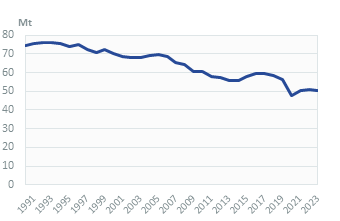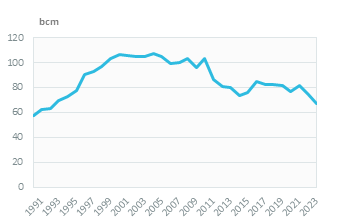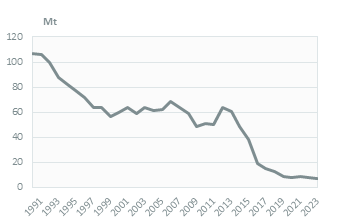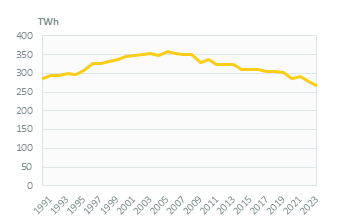-
-
 Energy and Climate Databases
Energy and Climate Databases- The most comprehensive and up-to-date annual energy database.
- Monitoring of technology providers in H2 supply chain.
- Monthly energy data on key energy markets.
- The most reliable and up-to-date power generation database.
- The essentials of LNG trade at your fingertips.
- Global monitoring of new and existing refineries.
- Analyse energy consumption and efficiency trends at world level. Benchmark countries.
- Have your database developed by a recognised expert of both energy and IT.
-
 Energy - Climate Forecasts
Energy - Climate Forecasts- Instant access to energy and emissions forecasts.
- Strategic, annual wholesale price projections backed by Enerdata's energy modelling expertise and our globally recognised POLES model.
- Wedges module showing a breakdown of the levers enabling to reduce emissions between two scenarios.
- Unique, independent projections of consumption by end-use.
- GHG Marginal Abatement Cost Curves.
- Benefit from proven models to draw your own energy scenarios and anticipate tomorrow’s challenges.
-
 Market Intelligence
Market Intelligence- 110 Energy and climate country reports
- A newsletter to receive the latest updates on evolving technologies and policies.
- Global energy news and analyses curated daily.
- Enerdata’s experts bring you the essentials about your market and competitors.
-
-
-
 Market Analysis
Market Analysis- Understanding key consumption trends and drivers across sectors.
- Granular and exclusive insight to address the most pressing business and strategic issues.
- Expertise in strategic and business intelligence, with fine-tuning to the market’s specificities.
-
 Energy - Climate Scenarios
Energy - Climate Scenarios- Providing the outlook of an energy commodity in mid to long term time horizons.
- Sector and driver specific energy demand forecasting.
- Assess the evolution of energy prices on the international and regional markets, as well as end-users prices.
- Enerdata guides you through pathways to reach climate targets.
- Supporting local authorities in their decarbonisation strategies.
-
 Climate Strategy and Policy Evaluation
Climate Strategy and Policy Evaluation- Cutting-edge quantitative tools and relevant indicators to monitor and evaluate evolutions on worldwide energy markets.
- Analysis of the most cost-effective options to reduce emissions.
- Quantified simulation and analysis of pledges for climate change negotiations.
- Breakdown and analysis of carbon markets.
- Enerdata guides you on the most beneficial policy or investment options.
- Turning climate objectives into concrete action plans.
-
 Training
Training- Understand different policy targets and measures on energy efficiency.
- How to measure energy savings?
- Energy Forecasting is a 2 days training to learn to design and interpret energy forecasts.
- Energy statistics training allowing to create energy balance with supply, transformation and consumption and understanding the international energy statistics regulations.
- Initiation to EnerMED level 1is the training to approach on the most powerful energy demand forecasting model.
-
-
Resource Centre
United Kingdom Key Figures
- Population:
- 67.3 million
- GDP growth rate:
- 0.15 %/year
- Energy independence:
- 64.5%
Data of the last year available: 2023
- Total consumption/GDP:*
- 53.0 (2005=100)
- CO2 Emissions:
- 4.32 tCO2/capita
- Rate of T&D power losses:
- 9.21%
* at purchasing power parity
View all macro and energy indicators in the United Kingdom energy report
United Kingdom Related News
View all news, archive your new and create your own daily newsletters only on your topics/countries of interest with Key Energy Intelligence
United Kingdom Related Research
Benefit from up to 2 000 up-to-date data series for 186 countries in Global Energy & CO2 data
A data overview is available in the global energy statistics app
Total Energy Consumption
Consumption per capita has shrunk by almost a third since 2000, bringing it to 2.2 toe in 2023. Electricity consumption per capita dropped by 30%, from 5 800 kWh in 2000 to 3990 kWh in 2023.
In 2023, energy consumption at normal climate decreased by 5% to 145 Mtoe, a similar decrease as in 2022. In 2021, consumption increased by 3% and in 2020, it dropped by 8%. Previously, between 2003 and 2019, energy consumption at normal climate decreased by almost 2%/year.
Graph: CONSUMPTION TRENDS BY ENERGY SOURCE (Mtoe)
Interactive Chart United Kingdom Total Energy Consumption
Benefit from up to 2 000 up-to-date data series for 186 countries in Global Energy & CO2 data
View the detailed fondamentals of the market at country level (graphs, tables, analysis) in the United Kingdom energy report
Crude Oil Production
Since 2019, crude oil production has declined by more than 10%/year, reaching 34 Mt in 2023. Previously, it rebounded by 5.5%/year between 2014 and 2019 from 40 Mt to 53 Mt. Over 1999-2014, oil production decreased by 8%/year from a peak of 137 Mt to 40 Mt.
The UK became a net crude oil importer in 2005 (15 Mt of net imports in 2022).
Interactive Chart United Kingdom Crude Oil Production
Benefit from up to 2 000 up-to-date data series for 186 countries in Global Energy & CO2 data
Additionally, for more detailed information on refineries, you can request a sample of our EMEA Refineries Dataset
Oil Products Consumption
Oil consumption decreased by 0.9% in 2023 to 50 Mt following a 2% decline in 2022. It rebounded by 6% in 2021 after a 15% decrease in 2020. Previously, oil consumption declined by 2%/year between 2017 and 2019 after a 2%/year increase between 2013 and 2017, led by the transport and petrochemical sectors. In 2023, oil consumption was 26% below its peak level in 2003.
Graph: OIL CONSUMPTION (Mt)

Interactive Chart United Kingdom Refined Oil Products Production
Benefit from up to 2 000 up-to-date data series for 186 countries in Global Energy & CO2 data
Additionally, for more detailed information on refineries, you can request a sample of our EMEA Refineries Dataset
Natural Gas Consumption
In 2023, natural gas consumption declined by 10.4% (reaching 67 bcm), after experiencing an 8% decrease in 2022 and a 6% decrease in 2021 and 2020. Between 2016 and 2019, gas consumption was relatively stable at around 80 bcm. Previously, gas consumption increased by 14% between 2014 and 2016, after a 30% decline over 2004-2014.
Graph: NATURAL GAS CONSUMPTION (bcm)

Interactive Chart United Kingdom Natural Gas Domestic Consumption
Benefit from up to 2 000 up-to-date data series for 186 countries in Global Energy & CO2 data
Additionally, for more detailed information on the LNG trade, you can request a sample of our EMEA LNG Trade Dataset
Coal Consumption
Coal consumption continued to decline by 13% in 2023 to 6.8 Mt, following a 15% decrease in 2022. In 2021 it increased by 4% following a slight rebound in coal-fired generation. In 2020, it dropped by 9%. Previously, it had decreased by 21%/year between 2012 and 2020 due to the closure of numerous coal-fired power plants.
Graph: COAL CONSUMPTION (Mt)

Interactive Chart United Kingdom Coal and Lignite Domestic Consumption
Benefit from up to 2 000 up-to-date data series for 186 countries in Global Energy & CO2 data
View the detailed consumption trends at country level (graphs, tables, analysis) in the United Kingdom energy report
Power Consumption
In 2023, electricity consumption declined by 3.3% to 267 TWh, after a 4.5% decrease in 2022. In 2021, it rebounded by 1.2% after a 5.2% drop in 2020. Between 2005 and 2019, electricity consumption declined on average by 1.2%/year. In 2023, electricity consumption was 25% below its peak level in 2005.
Graph: ELECTRICITY CONSUMPTION (TWh)

Households are the main electricity consumers (35%), followed by services (29%) and industry (29%).
Renewable in % Electricity Production
In 2023, the government committed to fully decarbonise the power system by 2035. This commitment includes the development of up to 50 GW of offshore wind by 2030 (5 GW of which is floating offshore wind) and a final investment decision on a large-scale nuclear plant. In 2020, the National Infrastructure Commission (NIC) updated its target for deployment of renewables as part of a carbon-free electricity system, from 50% to 65% of the power mix by 2030 (44% in 2022).
The target of 20 GW of solar in 2020 set in the Solar Strategy of 2014 was not reached (14 GW end of 2020).
Interactive Chart United Kingdom Share of Renewables in Electricity Production (incl hydro)
Benefit from up to 2 000 up-to-date data series for 186 countries in Global Energy & CO2 data
Learn more about renewables in the European Battery Market Analysis
CO2 Fuel Combustion/CO2 Emissions
In its updated NDC (2022), the country aims to reduce its GHG emissions by 68% by 2030 from 1990 level, compared to 53% in the previous NDC. In 2021, the country set into law a new reduction target of 78% in 2035 and reached 60% of this target that same year (47% reduction achieved).
GHG emissions have decreased by 53% since 1990, reaching 384 MtCO2eq in 2023 (provisional estimate). Almost 2/3 of this reduction has been achieved since 2010 (34%, of which 5.4% in 2023).